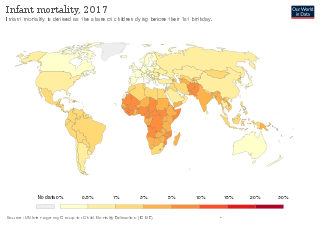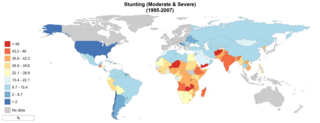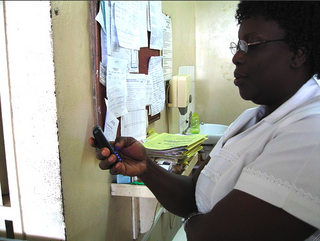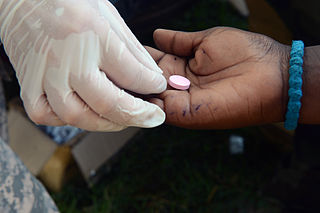
Infant mortality is the death of young children under the age of 1. This death toll is measured by the infant mortality rate (IMR), which is the probability of deaths of children under one year of age per 1000 live births. The under-five mortality rate, which is referred to as the child mortality rate, is also an important statistic, considering the infant mortality rate focuses only on children under one year of age.

Mortality rate, or death rate, is a measure of the number of deaths in a particular population, scaled to the size of that population, per unit of time. Mortality rate is typically expressed in units of deaths per 1,000 individuals per year; thus, a mortality rate of 9.5 in a population of 1,000 would mean 9.5 deaths per year in that entire population, or 0.95% out of the total. It is distinct from "morbidity", which is either the prevalence or incidence of a disease, and also from the incidence rate.

Family planning services are “the ability of individuals and couples to anticipate and attain their desired number of children and the spacing and timing of their births. It is achieved through use of contraceptive methods and the treatment of involuntary infertility.” Family planning may involve consideration of the number of children a woman wishes to have, including the choice to have no children and the age at which she wishes to have them. These matters are influenced by external factors such as marital situation, career considerations, financial position, and any disabilities that may affect their ability to have children and raise them. If sexually active, family planning may involve the use of contraception and other techniques to control the timing of reproduction.

Maternal death or maternal mortality is defined by the World Health Organization (WHO) as "the death of a woman while pregnant or within 42 days of termination of pregnancy, irrespective of the duration and site of the pregnancy, from any cause related to or aggravated by the pregnancy or its management but not from accidental or incidental causes." These maternal deaths are divided into two categories: direct obstetric deaths and indirect obstetric deaths. The latter are deaths for which there was a preexisting disease that was aggravated by the pregnancy. Another WHO classification is late maternal death which both direct and indirect deaths that occur after 42 days but less than one year after the pregnancy outcome.

Social mobility is the movement of individuals, families, households, or other categories of people within or between social strata in a society. It is a change in social status relative to one's current social location within a given society. This movement occurs between layers or tiers in an open system of social stratification. Open stratification systems are those in which at least some value is given to achieved status characteristics in a society. The movement can be in a downward or upward direction. Markers for social mobility, such as education and class, are used to predict, discuss, and learn more about an individual or a group's mobility in society.

Early childhood education is a branch of education theory that relates to the teaching of children from birth up to the age of eight. Traditionally, this is up to the equivalent of third grade. ECE emerged as a field of study during the Enlightenment, particularly in European countries with high literacy rates. It continued to grow through the nineteenth century as universal primary education became a norm in the Western world. In recent years, early childhood education has become a prevalent public policy issue, as municipal, state, and federal lawmakers consider funding for preschool and pre-K. The global priority placed on early childhood education is underscored with targets of the United Nations Sustainable Development Goal 4. It is described as an important period in a child's development. It refers to the development of a child's personality. ECE is also a professional designation earned through a post-secondary education program. For example, in Ontario, Canada, the designations ECE and RECE may only be used by registered members of the College of Early Childhood Educators, which is made up of accredited child care professionals who are held accountable to the College's standards of practice.
India's population, as per 2011 stood at 1.21 billion. There are great inequalities in health between states. The infant mortality in Kerala is 6 per thousand live births, but in Uttar Pradesh it is 64.
Calestous Juma was a Kenyan scientist and academic specialising in sustainable development. He was named one of the most influential 100 Africans in 2012, 2013 and 2014 by the New African magazine. He was Professor of the Practice of International Development and Faculty Chair of the Innovation for Economic Development Executive Program at Harvard Kennedy School. Juma was Director of the School's Science, Technology and Globalization Project at Harvard Kennedy School as well as the Agricultural Innovation in Africa Project funded by the Bill and Melinda Gates Foundation. His last book, Innovation and Its Enemies: Why People Resist New Technologies. was published by Oxford University Press in 2016.

Stunted growth is a reduced growth rate in human development. It is a primary manifestation of malnutrition and recurrent infections, such as diarrhea and helminthiasis, in early childhood and even before birth, due to malnutrition during fetal development brought on by a malnourished mother. The definition of stunting according to the World Health Organization (WHO) is for the "height for age" value to be less than two standard deviations of the WHO Child Growth Standards median.

mHealth is an abbreviation for mobile health, a term used for the practice of medicine and public health supported by mobile devices. The term is most commonly used in reference to using mobile communication devices, such as mobile phones, tablet computers and personal digital assistants (PDAs), and wearable devices such as smart watches, for health services, information, and data collection. The mHealth field has emerged as a sub-segment of eHealth, the use of information and communication technology (ICT), such as computers, mobile phones, communications satellite, patient monitors, etc., for health services and information. mHealth applications include the use of mobile devices in collecting community and clinical health data, delivery/sharing of healthcare information for practitioners, researchers and patients, real-time monitoring of patient vital signs, the direct provision of care as well as training and collaboration of health workers.

Science and technology is a growing field in Pakistan and has played an important role in the country's development since its founding. Pakistan has a large pool of scientists, engineers, doctors, and technicians assuming an active role in science and technology. Liaquat Ali Khan the first Prime Minister of Pakistan, made various reforms to initiate improvement in higher education and scientific research. The real growth in science in Pakistan occurred after the establishment of the Higher education Commission in 2002 which supported science in a big way and also became the major sponsor of the Pakistan Academy of Sciences under the leadership of Prof. Atta-ur-Rahman. The first IT policy and implementation strategy was approved under the leadership of Prof. Atta-ur-Rahman, then Federal Minister of Science & technology, in August 2000 which laid the foundations of the development of this sector On the request of Prof. Atta-ur-Rahman, Intel initiated a nationwide programme to train school teachers in Information and Communication technologies in March 2002 which has led to the training of 220,000 school teachers in 70 districts and cities across Pakistan. A 15-year tax holiday was approved on the recommendation of Prof. Atta-ur-Rahman which has resulted in growth of IT business from $30 million in 2001 to over $3 billion. The Pakistan Austria University of Applied Engineering (Fachhochschule) is now being established in Haripur Hazara under the Chairmanship of Prof. Atta-ur-Rahman in which students will get degrees from several Austrian universities. Pakistan's growth in scientific output can be seen from the fact that in 1990 Pakistan published 926 scholarly documents while in 2018 the number rose to 20548, a twenty times increase.In contrast India published 21443 scholarly documents in 1990 and the number rose to 171356 in 2018, an eight times increase. In 2018, 336 people per million were researchers in the R&D in Pakistan compared to 256 people per million being researchers in India.

The National Health Mission (NHM) was launched by the government of India in 2013 subsuming the National Rural Health Mission and National Urban Health Mission. It was further extended in March 2018, to continue until March 2020. It is headed by Mission Director and monitored by National Level Monitors appointed by the Government of India.

GAVI, officially Gavi, the Vaccine Alliance is a public–private global health partnership with the goal of increasing access to immunisation in poor countries.

WHO has defined health as "a state of complete physical, mental, and social well-being and not merely the absence of disease or infirmity." Identified by the 2012 World Development Report as one of two key human capital endowments, health can influence an individual's ability to reach his or her full potential in society. Yet while gender equality has made the most progress in areas such as education and labor force participation, health inequality between men and women continues to plague many societies today. While both males and females face health disparities, girls and women experience a majority of health disparities. This comes from the fact that many cultural ideologies and practices have structured society in a way whereby women are more vulnerable to abuse and mistreatment, making them more prone to illnesses and early death. Females are underrepresented in clinical trials and subjected to physician bias in diagnosis and treatment. Women are also restricted from receiving many opportunities, such as education and paid labor, that can help improve their accessibility to better health care resources.

Undernutrition in children, where an individual is not getting enough calories, protein, or micronutrients, is common globally and may result in both short and long term irreversible negative health outcomes. This is also sometimes called malnutrition, but this could also refer to getting too much food. The World Health Organization (WHO) estimates that malnutrition accounts for 54 percent of child mortality worldwide, about 1 million children. Another estimate also by WHO states that childhood underweight is the cause for about 35% of all deaths of children under the age of five years worldwide.

Mass deworming, also called preventive chemotherapy, is the process of treating large numbers of people, particularly children, for helminthiasis and schistosomiasis in areas with a high prevalence of these conditions. It involves treating everyone – often all children who attend schools, using existing infrastructure to save money – rather than testing first and then only treating selectively. Serious side effects have not been reported when administering the medication to those without worms, and testing for the infection is many times more expensive than treating it. So for the same amount of money, mass deworming can treat more people more cost-effectively than selective deworming. Mass deworming is one example of mass drug administration.
Science and Technology is Jordan's fastest-growing economic sector. This growth is occurring across multiple industries, including information and communications technology (ICTs), solar and wind energy and nuclear technology.
Robert Michael Hecht is an American global health policy and financing expert. Hecht is currently Founder and President of Pharos Global Health Advisors. He has previously held positions with the World Bank, UNAIDS, the International AIDS Vaccine Initiative, and Results for Development Institute. He serves as a lecturer at Yale University’s Jackson Institute for Global Affairs and is a clinical professor at the Yale School of Public Health. He has published on a range of topics in global health and development, with a special focus on the economics, financing, and policies for infectious diseases, nutrition, and broader health system reform. He has been an advisor to the President's Emergency Plan for AIDS Relief (PEPFAR), the World Health Organization, and UNITAID. Hecht holds a BA from Yale and a PhD from Cambridge University.

Sustainable Development Goal 2 aims to achieve "zero hunger". It is one of the 17 Sustainable Development Goals established by the United Nations in 2015. The official wording is: “End hunger, achieve food security and improved nutrition and promote sustainable agriculture". SDG 2 highlights the complex inter-linkages between food security, nutrition, rural transformation and sustainable agriculture. According to the United Nations, there are around 690 million people who are hungry, which accounts for 10 percent of the world population. One in every nine people goes to bed hungry each night, including 20 million people currently at risk of famine in South Sudan, Somalia, Yemen and Nigeria.
Caroline Susan E. Homer is an Australian midwifery researcher and international advocate for women's health rights. She is Co-Program Director, Maternal and Child Health at the Burnet Institute in Melbourne and Visiting Distinguished Professor of Midwifery at the University of Technology Sydney.














